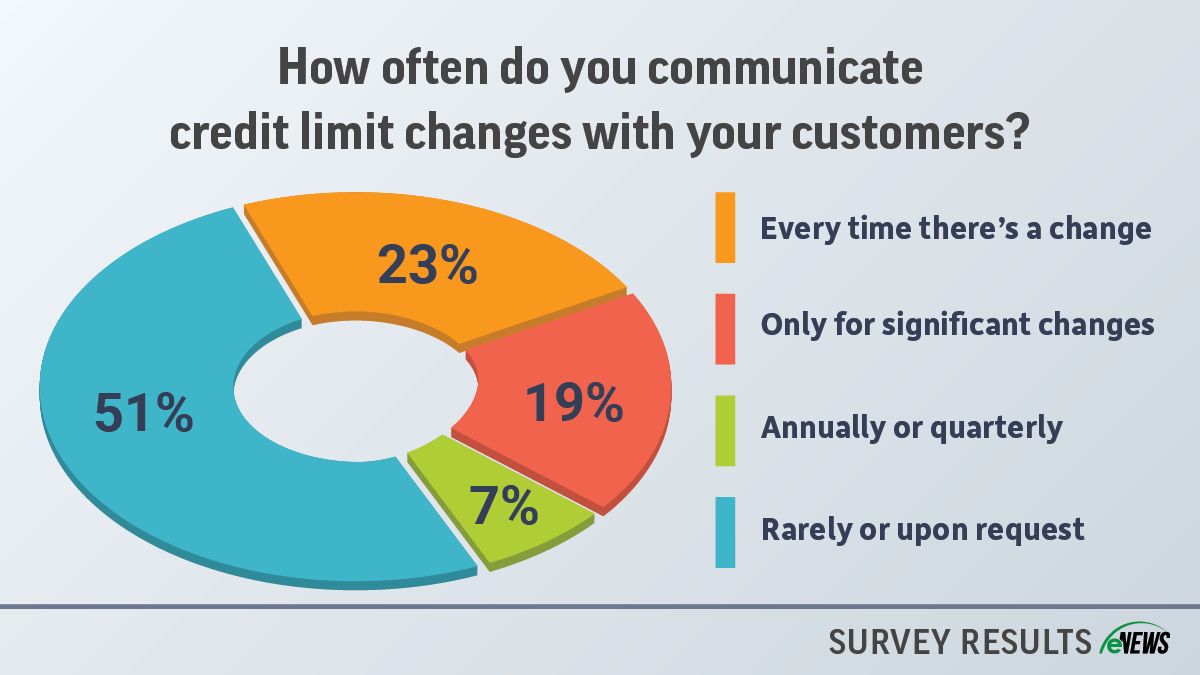Business Practices, eNews
Credit limit changes: How often should customers be notified?

When it comes to managing credit limits, every credit manager has a unique approach shaped by their industry, company size and customer base.
Why it matters: Whether adjusting limits regularly or seldom making changes, the key challenge lies in how—and when—to communicate these changes to customers. While some credit managers prefer to keep customers informed at every step, others take a more reserved approach, sharing updates only when prompted or under specific circumstances.
By the numbers: According to an eNews poll, 51% of credit managers reported rarely alerting customers to changes in credit limits, opting instead to provide the information when prompted. Comparatively, 23% of those polled report telling customers about all changes to the credit limit while 19% said they communicate only significant changes.
Do B2B customers care about credit limits?
For many customers, credit limits are not a primary concern as long as they do not interfere with their ability to place orders and receive shipments on time.
Jane Hughes, CBA, credit and AR manager at Max-Tech Inc. (Hamel, MN), finds that credit limits are in place largely for her to monitor customer activity. When customers are slow to pay or enter default after owing for a significant period of time, lowering their credit line is an easy way to keep a closer eye on that account by monitoring orders and shipments closely. “As a credit manager, I change credit lines all the time,” Hughes said. “It gives us a way to better keep an eye on customers who have been slow pay.”
While Hughes is always open to sharing credit limits with customers, she says it is rare that any will ask. “I don’t think most customers really care what their credit limit is,” Hughes said. “As long as they can place the number of orders that they need and it’s not causing delays in shipment.”
When credit limits are lowered, it is often because of missed payments, so customers are alerted to changes that might restrict their buying habits due to their negligence. While not all customers may be concerned with the specifics of their credit limits, they do care when these limits impact their operations.
“When we lower credit limits, typically, we’re taking them away completely because they’re far enough past due that we’re automatically locking down that credit limit,” said Jason Mott, CCE, NACM Board director and corporate credit manager at MFA Incorporated (Columbia, MO). “Our communication with the customer in those instances would be through past-due letters.”
For Jon Hanson, CCE, CCRA, VP-director of corporate credit at OVOL USA (Carrollton, TX), different circumstances mean different approaches to communication. For example, a credit manager might reach out to customers to discern a bit more information that could inform the amount of the limit. Many credit managers will seek out external resources that could reveal more information about a customer’s payment habits, but occasionally this search might not yield many results.
Without additional intel, credit managers will be apprehensive with accommodating a higher credit line. “In that case, we would have a conversation with the customer,” Hanson said. “And we would say, ‘Hey, your credit line is X, we really need it to be Y because of the orders that you’re trying to place with us. Can you maybe give us some financial information, for example, to help us bridge that gap?’”
Many credit managers prefer to inform customers about changes in their credit line only during extenuating circumstances, but others choose to proactively communicate these changes to their customers. Deana Reynolds, director of credit for Edges Electrical Group (Sacramento, CA), alerts customers about any changes to their credit limit, even when they might seem relatively minor.
“We want to make sure we always communicate to the customer, even if it’s something negative, like lowering a credit limit,” Reynolds said. “We want to make sure that everyone is fully aware, because otherwise you get in a situation where the customer is sending their field techs to our sales counter to pick up orders and they can’t get them, and that puts everybody in a really, really awkward position.”
The bottom line: The decision to communicate credit limit changes should be guided by the nature of the relationship, the industry and the potential impact on the customer’s business. Credit managers who work in industries that provide commodities might find their credit lines and limits are changed more than those who work in construction.





